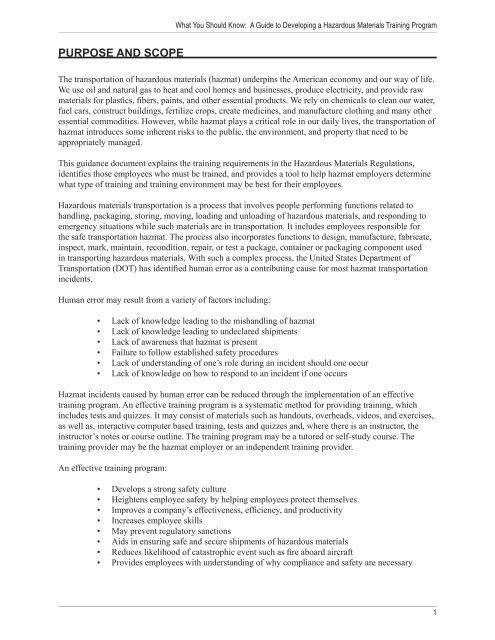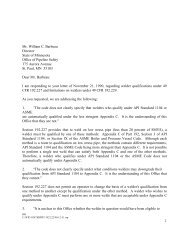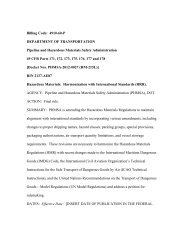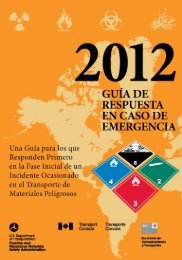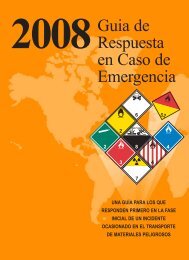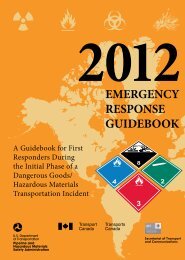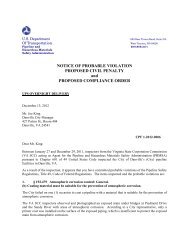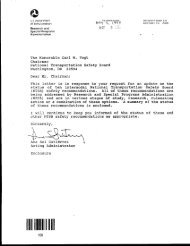Training Guidance7609am.indd - PHMSA - U.S. Department of ...
Training Guidance7609am.indd - PHMSA - U.S. Department of ...
Training Guidance7609am.indd - PHMSA - U.S. Department of ...
You also want an ePaper? Increase the reach of your titles
YUMPU automatically turns print PDFs into web optimized ePapers that Google loves.
PURPOSE AND SCOPE<br />
What You Should Know: A Guide to Developing a Hazardous Materials <strong>Training</strong> Program<br />
The transportation <strong>of</strong> hazardous materials (hazmat) underpins the American economy and our way <strong>of</strong> life.<br />
We use oil and natural gas to heat and cool homes and businesses, produce electricity, and provide raw<br />
materials for plastics, fi bers, paints, and other essential products. We rely on chemicals to clean our water,<br />
fuel cars, construct buildings, fertilize crops, create medicines, and manufacture clothing and many other<br />
essential commodities. However, while hazmat plays a critical role in our daily lives, the transportation <strong>of</strong><br />
hazmat introduces some inherent risks to the public, the environment, and property that need to be<br />
appropriately managed.<br />
This guidance document explains the training requirements in the Hazardous Materials Regulations,<br />
identifi es those employees who must be trained, and provides a tool to help hazmat employers determine<br />
what type <strong>of</strong> training and training environment may be best for their employees.<br />
Hazardous materials transportation is a process that involves people performing functions related to<br />
handling, packaging, storing, moving, loading and unloading <strong>of</strong> hazardous materials, and responding to<br />
emergency situations while such materials are in transportation. It includes employees responsible for<br />
the safe transportation hazmat. The process also incorporates functions to design, manufacture, fabricate,<br />
inspect, mark, maintain, recondition, repair, or test a package, container or packaging component used<br />
in transporting hazardous materials. With such a complex process, the United States <strong>Department</strong> <strong>of</strong><br />
Transportation (DOT) has identifi ed human error as a contributing cause for most hazmat transportation<br />
incidents.<br />
Human error may result from a variety <strong>of</strong> factors including:<br />
•<br />
•<br />
•<br />
•<br />
•<br />
•<br />
Lack <strong>of</strong> knowledge leading to the mishandling <strong>of</strong> hazmat<br />
Lack <strong>of</strong> knowledge leading to undeclared shipments<br />
Lack <strong>of</strong> awareness that hazmat is present<br />
Failure to follow established safety procedures<br />
Lack <strong>of</strong> understanding <strong>of</strong> one’s role during an incident should one occur<br />
Lack <strong>of</strong> knowledge on how to respond to an incident if one occurs<br />
Hazmat incidents caused by human error can be reduced through the implementation <strong>of</strong> an effective<br />
training program. An effective training program is a systematic method for providing training, which<br />
includes tests and quizzes. It may consist <strong>of</strong> materials such as handouts, overheads, videos, and exercises,<br />
as well as, interactive computer based training, tests and quizzes and, where there is an instructor, the<br />
instructor’s notes or course outline. The training program may be a tutored or self-study course. The<br />
training provider may be the hazmat employer or an independent training provider.<br />
An effective training program:<br />
•<br />
•<br />
•<br />
•<br />
•<br />
•<br />
•<br />
•<br />
Develops a strong safety culture<br />
Heightens employee safety by helping employees protect themselves<br />
Improves a company’s effectiveness, effi ciency, and productivity<br />
Increases employee skills<br />
May prevent regulatory sanctions<br />
Aids in ensuring safe and secure shipments <strong>of</strong> hazardous materials<br />
Reduces likelihood <strong>of</strong> catastrophic event such as fi re aboard aircraft<br />
Provides employees with understanding <strong>of</strong> why compliance and safety are necessary<br />
1


